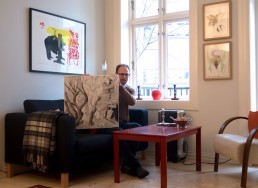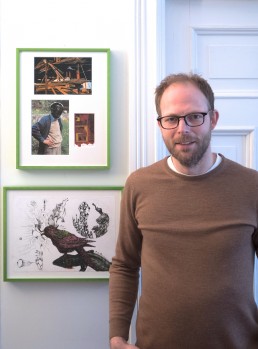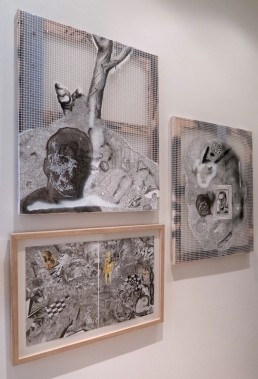Interviews
Interview: Art Collector Erik R. Nergaard

Although he never intended to become an art collector, Erik R. Nergaard ended up being dedicated to art; looking at art, discussing it, reading about it, and… collecting it. The Norwegian collector grew up surrounded by art, but it was not until later that he took up collecting, which marked the entrance to a completely new space for him to let his imagination run wild. In this interview, Erik R. Nergaard talks about the becoming of an art collection circling around the themes of nature and existentialism.
Name: Erik R. Nergaard
Location: Oslo
Started collecting in year: 2015
Number of artworks in collection: approx. 35
Name of collection: The Erne Collection (working title)
What is your earliest memory of art, and what led you to start collecting it?
Hmm, I have no clear ‘earliest memory’, if you mean a kind of moment when I first got conscious of art. When I grew up, we had paintings and prints at home, and in kindergarten and at school, we visited places like the National Gallery and the Vigeland Park and Museum in Oslo, so I have always been around art, I suppose. However, I vividly remember a visit to Fondation Maeght in France on a family holiday some time during the 1990s, seeing the works of Alberto Giacometti and Francis Bacon for the first time. That was certainly an eye-opener. Yet, it took many years before I started to buy art, and that was triggered, I think, by Sverre Bjertnes’s great exhibition Nervous Fluids at the Stenersen Museum in Oslo in 2014 – I remember really wanting one of his works! I never intended to become an art collector, though.
How would you describe yourself as an art collector?
A collection is really the outcome of a selection process, as you cannot have them all! (And sadly too often not even a few more, or even that one more work that you really want). So, I suppose the question is how I make my selections. I have read about collectors who let their hearts decide, collecting “con amore”, while others are more strategically minded and disciplined, having thought out a set of selection criteria that they then strenuously follow. The latter is of course the way of the professional. As to me, I suppose I tend to follow my heart more, but I am also trying to figure out what ties my collection together more thematically. I also try to read a lot.

What is the main motivation behind your collecting?
The love of arts! If you are open to it, art can help you see familiar things in unfamiliar and surprising ways, which makes life richer. I have also found that collecting art makes you, or at least me, more committed to learning more, so you may better understand what is hanging on your wall. If you love art, you also have to realize that it does not come for free. The artists need support, financially and otherwise, in order to keep creating.
Describe your collection in three words.
Then we are talking about themes again. Perhaps nature-related (in lack of a better word to coin our relationship to nature), existentialist and contemporary?
Is there any particular type of art that appeals to you or anything that unites all the works in your collection?
I clearly have a thing for drawings, as the majority of the works in my collection are drawings. Contrasts of black and white also appeal to me, as well as their use in symbolism of ‘darkness’ and ‘light’. However, the collection also consists of prints and paintings and colourful works, as well as both works that are abstract and more or less figurative. So, it is hard to tell.

How important is it for you to meet the artist behind the artwork?
Hmm, I have met a few, which have been pleasant and interesting. However, it should not be necessary to meet the artist, I think, as art should be able to speak for itself and resonate with the viewer without further explanation. That said, explanations, background stories and the like can of course make you understand the work differently.
What is the most recent piece of art you added to your collection and why?
A drawing on canvas by Martin Schreiner. Well, it appealed very strongly to me, and he is one of my favourite young artists.
Has digitalization changed the way you collect art?
I am not old enough as a collector to remember what it was like to collect art before digitalization, so I guess the answer is no.

What or who has influenced you as a collector?
I should probably be conscious of this, but I am afraid I am not.
Is there any specific place you always return to when you need an art fix?
Not really, but I visit some places more often than others – probably QB gallery and Golsa in Oslo most frequently.
The art market has a reputation of being a playground for the elite. What is your experience of this?
If there is an elite amongst buyers and sellers of art in Oslo, I do not think I have come across it yet – or I have not noticed it anyway. In my experience, you do not have to belong to some elite to feel welcome at art galleries and museums in Oslo, or at art auctions for that matter.
Where do you think the future of the art market is headed?
Hard to say. I hope to see more young collectors and curious people joining in.
Top three pieces of advice for new collectors
1. Visit galleries and do not be afraid to ask the gallerists about the works, artists, or whatever – they should welcome your interest!
2. Buy something you like, then try to figure out what you like about it (and dislike), compare it to other works and use it as a reference for future acquisitions.
3. Do not expect that collecting art will make you a fortune.
Top three art destinations
1. Rome
2. Florence
3. Paris
Three inspiring artists to watch
1. Martin Schreiner
2. Christian Tony Norum
3. Ingri Haraldsen & Petter Buhagen (they often exhibit their works together)